Given the robust nature of learning sciences research, this website is best viewed on tablets and computers. A small screen experience is coming in the future.
On June 22, 2021, we will launch updated strategies for the Math PK-2 model, as well as additional updates to the Navigator that highlight equity, SEL, and culturally responsive teaching. To learn more, visit our Site Updates (available in the "About" menu at the top of any page).

Hover to see how factors connect to Inhibition & Self-regulation. Then click connected factors to explore strategies related to multiple factors.
Inhibition & Self-regulation work together to help students concentrate on learning. Inhibition is the ability to suppress Attention to irrelevant input and focus on pertinent stimuli or information, and Self-regulation is the ability to alter and regulate our behavioral responses. By helping students control their focus and self-regulate their behavior, Inhibition and Self-regulation are critical supports for becoming a successful reader and writer.
Advance graphic organizers link prior knowledge to upcoming learning to help students anticipate and understand the structure of new information.
Audiobooks allow students to hear fluent reading and to experience books above their reading skills.
Students practice making and finding meaning in their reading through a book club model.
Content that is provided in clear, short chunks can support students' Working Memory.
Building positive and trusting relationships with learners allows them to feel safe; a sense of belonging; and that their academic, cognitive, and social and emotional needs are supported.
Checklists and rubrics help students develop their abilities to self-assess and revise their writing.
When peers are able to work together to plan, draft, edit, and revise their compositions, their writing quality improves.
Students activate more cognitive processes by exploring and representing their understandings in visual form.
Daily review strengthens previous learning and can lead to fluent recall.
Dim or natural lighting provides a calming environment.
When teachers provide explicit instruction in comprehension strategies and model when to use them, students learn how to flexibly apply them to make meaning of texts.
Explicitly teaching strategies for different genres, like narrative or persuasive writing, helps students write for different purposes and audiences.
Seeing and using new words repeatedly and in many contexts is critical for Vocabulary acquisition.
Research shows that, along with traditional reading comprehension strategies, students use unique strategies to read the non-linear, hyperlinked structure of online texts.
Explicitly teaching strategies for planning, writing, and revising texts improves students' writing quality.
Teaching students how to label, identify, and manage emotions helps them learn Inhibition & Self-Regulation skills.
Increasing how much students write improves both their writing and their reading.
Providing constructive feedback supports students' writing development by letting them know how to improve their writing.
As students walk through stations working in small groups, the social and physical nature of the learning supports deeper understanding.
Adding gestures and motions to complement learning activates more cognitive processes for recall and understanding.
Setting overall goals, as well as smaller goals as steps to reaching them, encourages consistent, achievable progress and helps students feel confident in their skills and abilities.
Visualizing how ideas fit together helps students construct meaning and strengthens their recall.
Providing feedback that focuses on the process of developing skills conveys the importance of effort and motivates students to persist when learning.
In guided inquiry, teachers help students use their own language for constructing knowledge by active listening and questioning.
Spending time with new content helps move concepts and ideas into Long-term Memory.
Practicing until achieving several error-free attempts is critical for retention.
Having spaces where students can go supports self-regulation and individual deliberate practice.
As students work with and process information by discussing, organizing, and sharing it together, they deepen their understanding.
Journaling allows students to reflect on their thinking and feelings, process their learning, and connect new information to what they know.
Full sentence manipulatives allow students to practice producing more complex Syntax and writing.
Providing physical representations of parts of a sentence activates learners' mental processes.
Through short but regular mindfulness activities, students develop their awareness and ability to focus.
Short breaks that include mindfulness quiet the brain to allow for improved thinking and emotional regulation.
dBy sharing their own reading and writing, teachers can create a literacy community that supports students in finding meaning in their own work.
By talking through their thinking at each step of a process, teachers can model what learning looks like.
Brain breaks that include movement allow learners to refresh their thinking and focus on learning new information.
Instruction in multiple formats allows students to activate different cognitive skills to understand and remember the steps they are to take in their literacy work.
Multiple writing surfaces promote collaboration by allowing groups to share information easily as they work.
Playful activities can support the development of learners' Metacognition and also inspire their narratives and writing.
Helping students think about what they know about the topic of upcoming work helps activate their Background Knowledge or reveals gaps.
Maintaining consistent classroom routines and schedules ensures that students are able to trust and predict what will happen next.
Cards with strategies for managing emotions help students remember how to act when faced with strong feelings.
When students read models of the type of writing they are doing, they can identify effective elements to incorporate in their writing.
Reading aloud regularly exposes students to new and familiar Vocabulary and texts.
Reading aloud books about skills children are learning provides another model for their development.
Through one-on-one conferences, teachers can provide individual support to each student to deepen comprehension and interest in reading.
When students explain to others, they deepen their understanding and gain confidence in their learning.
Providing space and time for students to reflect is critical for moving what they have learned into Long-term Memory.
Students build their confidence, strategy use, and comprehension by reading and rereading books.
Response devices boost engagement by encouraging all students to answer every question.
With figurative language and creative sentence structure, poetry supports the development of a deeper understanding of the different ways language makes meaning.
Books on social and emotional learning (SEL) topics, such as developing empathy and productive persistence, help teach these skills.
When students engage in a dialogue with themselves, they are able to orient, organize, and focus their thinking.
When students monitor their comprehension, performance, and use of strategies when reading and writing, they build their Metacognition.
Incorporating multiple senses with strategies like chewing gum, using a vibrating pen, and sitting on a ball chair supports focus and Attention.
Sentence frames or stems provide language support for students' writing and participation in academic discussions.
Providing ways for students to adjust sound level supports individual auditory needs.
Using earplugs or headphones can increase focus and comfort.
Providing students a voice in their learning is critical for making learning meaningful.
Providing ways for students to meet their individual temperature needs supports Attention and Inhibition & Self-Regulation.
Providing tools so learners can choose to listen to a text supports individual strengths and needs.
Students develop literacy skills by listening to and speaking with others in informal ways.
Timers help students learn how to self-pace and transition.
Tossing a ball, beanbag, or other small object activates physical focus in support of mental focus.
Spaces that are structured, organized, and clean provide increased room for collaboration and active learning.
Having students verbally repeat information such as instructions ensures they have heard the information and supports remembering.
Providing visuals to introduce, support, or review instruction activates more cognitive processes to support learning.
Videos developed with discussion guides can teach students about social and emotional learning (SEL) skills.
Visual supports, like text magnification, colored overlays, and guided reading strips, help students focus and properly track as they read.
Word sorts are multisensory activities that help learners identify patterns and group words based on different categories.
Writing conferences allow students to share, reflect on, and receive feedback about their writing, which promotes Motivation for revising.
 Except where otherwise noted, content on this site is licensed under a Creative Commons Attribution-NonCommercial 4.0 International License
Except where otherwise noted, content on this site is licensed under a Creative Commons Attribution-NonCommercial 4.0 International License
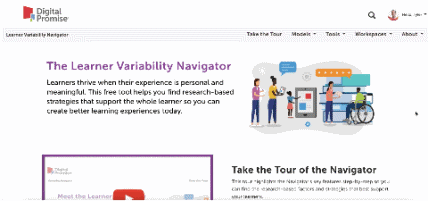
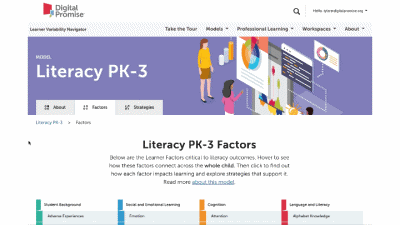
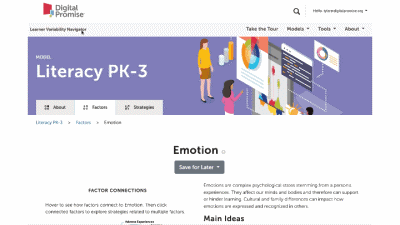
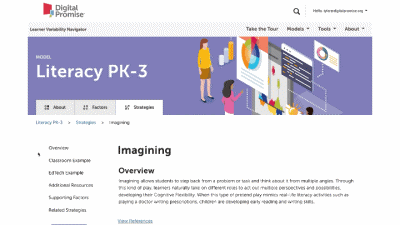
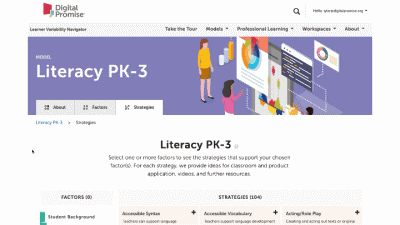
This is our homepage. You can access many of the features of the Navigator here, and learn more about how learner variability intersects with topics in education and learning. To start, select a content area – we call them Learner Models – to visit a factor map.
Factor maps show research-based concepts, "factors," that likely impact learning. They are organized into four categories: Learner Background, Social and Emotional Learning, Cognition, and Content Area. The map is interactive. Move your cursor over a factor to see connected factors. Select any factor to visit its summary page. We'll look at factor summary pages next.
This is a factor summary page. It provides a brief definition and review of the factor, a factor connections diagram, additional resources, and strategies that support this factor. On the strategy card, the multi-colored boxes show all the factors that it supports. Select a strategy to visit its summary page.
Strategy summary pages have an overview, information about using the strategy in different learning environments, resources of interest, the factors this strategy supports, and related strategies you can explore. To view all the strategies in a content area, use the strategies tab at the top of the page. We'll look at all the Strategies for this learner model next.
The strategy page shows ALL of the strategies for that learner model. You can select factors of interest for you or your learners, and it will narrow the strategies to only those that match all of the factors selected. This makes it easy to find key strategies to better design for learner variability. Again, select the strategy name to visit its summary page.
Are you sure you want to delete this Workspace?
Enter the email address of the person you want to share with. This person will be granted access to this workspace and will be able to view and edit it.
Adjust the permissions of your Workspace.
This Workspace is .
This Workspace's Reflection Area is .
Learner variability is the recognition that each learner is a unique constellation of strengths and challenges that are interconnected across the whole child. Understanding these connections and how they vary according to context is essential for meeting the needs of each learner.
It disrupts the notion of a one-size-fits all education. Understanding learner variability helps educators embrace both students’ struggles and strengths as we connect practice to uplifting the whole learner.
Throughout the site, we talk about "factors" and "strategies." Factors are concepts research suggests have an impact on how people learn. Strategies are the approaches to teaching and learning that can be used to support people in how they learn best.
Use the Learner Centered Design Tool to build a workspace. Go to Learner Centered Design Tool.
Or, create a new blank workspace for your product or project.
Use one of the guided tools to build a workspace.
Or, create a new blank workspace for your product or project.
Make a copy of this workspace.
Redirecting soon...
Generating summary page
Loading...
On this page, using your heatmap, you will be asked to select factors to further explore, and then select new strategies you might incorporate into upcoming instruction. Once done, click “Show Summary" to view your Design Summary Report.
On this page, using your heatmap, you will be asked to select factors to further explore, and then select new strategies you might incorporate into upcoming instruction. Once done, click “Show Report” to view your Design Summary Report.
By selecting "Show Report" you will be taken to the Assessment Summary Page. Once created, you will not be able to edit your report. If you select cancel below, you can continue to edit your factor and strategy selections.
Announcement here
Item successfully added to workspace!
Issue adding item to workspace. Please refresh the page and try again.
Learner variability is the recognition that each learner is a unique constellation of strengths and challenges that are interconnected across the whole child. Understanding these connections and how they vary according to context is essential for meeting the needs of each learner. It embraces both students’ struggles and strengths. It considers the whole child.
Throughout the site, we talk about "factors" and "strategies." Factors are concepts research suggests have an impact on how people learn. Strategies are the approaches to teaching and learning that can be used to support people in how they learn best.
The Learner Variability Navigator is a free, online tool that translates the science of learner variability into factor maps and strategies that highlight connections across the whole learner. This puts the science of learning at teachers' fingertips, empowering them to understand their own practice and support each learner.